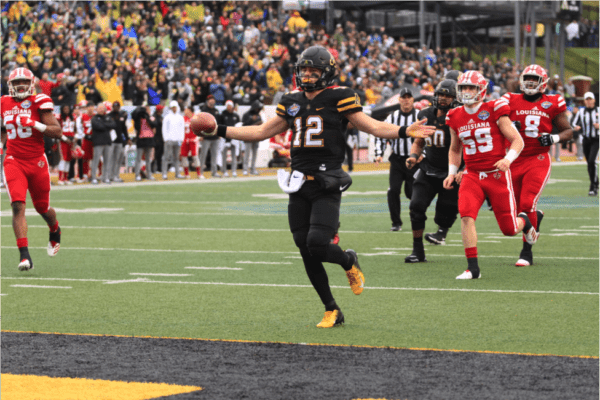
By Colby Gable
Predicting the 2019 season for App State quarterback Zac Thomas is in some part heavily reliant on the theoretical, as this year arrives with an abundance of small but vital details in the variation of the team’s anatomy itself. As Head Coach Drinkwitz mentioned more than once on media day, this season, in particular, holds a reverence for identity-creating, the curation of a “DNA” among the team to form a unification of sorts which allows them to understand strengths, weaknesses, and newly incorporated schematics in a somewhat equally new systemic design. This comes about with the arrival of Drinkwitz from NC State, where he served as the school’s Offensive Coordinator and led then quarterback Ryan Finley to be an NFL caliber quarterback, one which the Cincinnati Bengals traded up for in the 2019 draft. Yet it is the “newness” of the exterior, in this case, the coaching staff, which makes both the upside and the downside, admittedly, more into that of the abstract than the easily definable. However, there is one way I would argue we can find to think about how Thomas can fit into the unfamiliar, by examining statistics from last year, especially noteworthy being that of the QBR.
QBR, or Quarterback Rating, was a mathematical formula developed by those at ESPN to ascertain a graded performance for a quarterback based on: expected points added due to any positive or negative plays involving the quarterback (adjusted based on the difficulty of the play such as deep pass completions or pressure from the defense), passing yards after the catch, credit or discredit based on the strength of the opponent, and diluting points attributed when the game is out of reach. QBR measures a quarterback’s efficiency in areas that translate outside of simply sitting in the pocket and passing the ball, such as the ability to scramble and make plays on the run or with the pocket collapsing, and among the nation’s top twenty last season, Thomas ranked number thirteen at 79.8, only 1.2 points away from Panthers and post-West Virginia QB Will Grier, and 1.7 from Clemson’s projected Heisman candidate Trevor Lawrence.
Among a strain of QBR measurement is the Raw QBR which takes all of the normal factors into consideration apart from the strength of the opponent, where Thomas ranked fifth nationally beating out the likes of Grier, Lawrence, and Dwayne Haskins of Ohio State, now with the Washington Redskins. Because Thomas has been able to show a wide range of skills which exceed simply arm strength and accuracy, all of this comes together to show that regardless of the system he works in, Thomas has the potential to do well because he can contribute in a variety of ways outside that of throwing or simply reading coverages effectively to get the ball down the field, such as rushing or taking the play out of pocket without having to dilute production in the passing game. This gives Drinkwitz, who is also noted as taking over the main offensive coordinator duties as well as head coach, a bit more creativity in his play choice as Thomas is a more of a dual-threat than State’s Ryan Finley.
While last year’s 2018 team was a bit more dependent on the run considering the great output Jalin Moore Jr. had along with Thomas’ ability to deliver in option-based calls like we saw against Penn State in Week 1, comparatively, I expect the running game to be part of a balanced offense with a slight bias towards the passing game. This comes through the potentials of Thomas’ increasing skill and frequency to make things happen strictly in the pocket. Potential easily translatable to additional proficiently than last year because of how Drinkwitz could utilize him at the spot; by accenting the passing game as a whole. More specifically, connecting on deep or medium down-the-field-throws. Ultimately, Thomas has the talent to spark important plays in such diversely instinctual means, regardless of how Appalachian’s offensive system develops this year in which deviates from the previous staff, Thomas has worked himself into a solid position to have an even better season the last year’s in terms of productivity and overall individual impact on the game.



You must be logged in to post a comment.